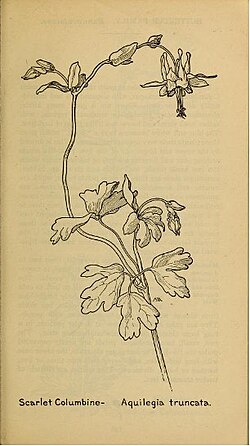Biology:Aquilegia truncata
| Aquilegia truncata | |
|---|---|

| |
| Scientific classification | |
| Kingdom: | Plantae |
| Clade: | Tracheophytes |
| Clade: | Angiosperms |
| Clade: | Eudicots |
| Order: | Ranunculales |
| Family: | Ranunculaceae |
| Genus: | Aquilegia |
| Species: | A. truncata
|
| Binomial name | |
| Aquilegia truncata Fischer & Meyer in F. E. L. von Fischer et al., Index Sem. Hort. Petrop. 9, suppl.: 8. 1844
| |
Aquilegia truncata, also known as the red columbine, is a flowering plant in the genus Aquilegia.
Description
This species grows 1 to 3 ft (0.30 to 0.91 m) high, with well-developed stem leaves that are light green. Flowers are nodding and over 1.5 in (38 mm) across. Outside of the corolla is pale-scarlet, veined and tipped with yellow; the inside is yellow and the spurs are erect and .75 in (19 mm) long.[1] The lamina 1-3mm long; follicles 15-20mm long.[2] Montane forms have short stems and very small stem leaves.[3] Similar dwarf montane races with the floral characters of A. formosa var. formosa occur in the Pacific Northwest; these have never been separated taxonomically.[3] Type locality: Fort Ross, California[2]
Habitat
Aquilegia truncata is found mostly in mesic woods or shrublands,[3] open woods or shady banks[2] in Oregon, Nevada and California ,[3] ranging from the upper Sororan to Canadian Zones; southern Oregon to northern Lower California and western Nevada.[2]
Conservation
There is little record of conservation for Aquilegia truncata. In 1935, Aquilegia truncata was part of a native restoration process in Yosemite National Park. Enrollees from one of Yosemite’s CCC camps collected numerous seeds of native fauna, including the Red Columbine, and planted them along Wawona Road in efforts to stabilize slopes. They used a new method where small trenches were dug laterally along the slopes, seeded, and then filled with duff and topsoil.[4]
References
- ↑ Armstrong, Margaret (1915) (in EN). Field Book of Western Wildflowers. New York & London: The Knickerbocker Press. pp. 134.
- ↑ 2.0 2.1 2.2 2.3 Abrams, Le Roy; Ferris, Roxana Stinchfield (1923) (in en). Illustrated Flora of the Pacific States: —Vol. II: Buckwheats to Kramerias. Stanford University Press. ISBN 978-0-8047-0004-7. https://books.google.com/books?id=Md_4wQqO5uQC&q=Aquilegia+truncata.
- ↑ 3.0 3.1 3.2 3.3 "Aquilegia formosa var. truncata - FNA". http://floranorthamerica.org/Aquilegia_formosa_var._truncata.
- ↑ "National Park Service: Presenting Nature (Chapter 6)". https://www.nps.gov/parkhistory/online_books/mcclelland/mcclelland6b3.htm.
Wikidata ☰ {{{from}}} entry
 |

